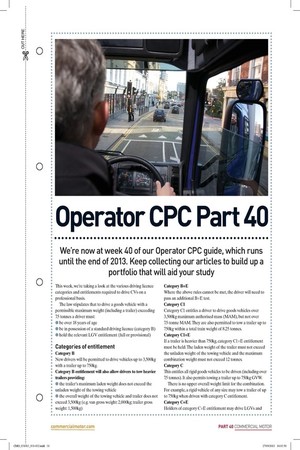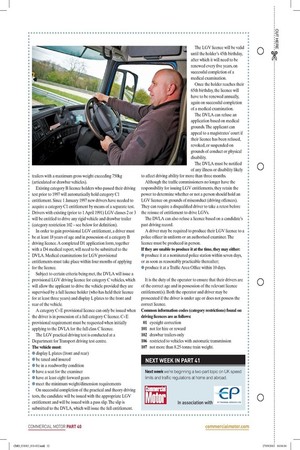Operator CPC Part 40
Page 24

Page 25

If you've noticed an error in this article please click here to report it so we can fix it.
Were now at week 40 of our Operator CPC guide, which runs until the end of 2013. Keep collecting our articles to build up a portfolio that will aid your study
This week, we're taking a look at the various driving licence categories and entitlements required to drive CVs on a professional basis. The law stipulates that to drive a goods vehicle with a permissible maximum weight (including a trailer) exceeding 7.5 tonnes a driver must: • be over 18 years of age • be in possession of a standard driving licence (category B) • hold the relevant LGV entitlement (full or provisional) Categories of entitlement Category B
New drivers will be permitted to drive vehicles up to 3,500kg with a trailer up to 750kg. Category B entitlement will also allow drivers to tow heavier trailers providing: • the trailer's maximum laden weight does not exceed the unladen weight of the towing vehicle • the overall weight of the towing vehicle and trailer does not exceed 3,500kg (e.g. van gross weight: 2,000kg; trailer gross weight: 1,500kg) Category B+E
Where the above rules cannot be met, the driver will need to pass an additional B+E test. Category Cl
Category Cl entitles a driver to drive goods vehicles over 3,500kg maximum authorised mass (MAM), but not over 7.5-tonne MAM. They are also permitted to tow a trailer up to 750kg within a total train weight of 8.25 tonnes. Category Cl+E
If a trailer is heavier than 750kg, category C1+E entitlement must be held. The laden weight of the trailer must not exceed the unladen weight of the towing vehicle and the maximum combination weight must not exceed 12 tonnes. Category C
This entitles all rigid goods vehicles to be driven (including over 7.5 tonnes). It also permits towing a trailer up to 750kg GVVV.
There is no upper overall weight limit for the combination. For example, a rigid vehicle of any size may tow a trailer of up to 750kg when driven with category C entitlement. Category C+E Holders of category C+E entitlement may drive LGVs and
trailers with a maximum gross weight exceeding 750kg (articulated or drawbar vehicles).
Existing category B licence holders who passed their driving test prior to 1997 will automatically hold category Cl entitlement. Since 1 January 1997 new drivers have needed to acquire a category Cl entitlement by means of a separate test. Drivers with existing (prior to 1 April 1991) LGV classes 2 or 3 will be entitled to drive any rigid vehicle and drawbar trailer (category restriction 102— see below for definition).
In order to gain provisional LGV entitlement, a driver must be at least 18 years of age and in possession of a category B driving licence. A completed D1 application form, together with a D4 medical report, will need to be submitted to the DVLA. Medical examinations for LGV provisional entitlements must take place within four months of applying for the licence.
Subject to certain criteria being met, the DVLA will issue a provisional LGV driving licence for category C vehicles, which will allow the applicant to drive the vehicle provided they are supervised by a full licence holder (who has held their licence for at least three years) and display L plates to the front and rear of the vehicle.
A category C+E provisional licence can only be issued when the driver is in possession of a full category C licence. C+E provisional requirement must be requested when initially applying to the DVLA for the full class C licence.
The LGV practical driving test is conducted at a Department for Transport driving test centre. The vehicle must: • display L plates (front and rear) • be taxed and insured • be in a roadworthy condition • have a seat for the examiner • have at least eight forward gears • meet the minimum weight/dimension requirements
On successful completion of the practical and theory driving tests, the candidate will be issued with the appropriate LGV entitlement and will be issued with a pass slip. The slip is submitted to the DVLA, which will issue the full entitlement.
The LGV licence will be valid until the holder's 45th birthday, after which it will need to be renewed every five years, on successful completion of a medical examination.
Once the holder reaches their 65th birthday, the licence will have to be renewed annually, again on successful completion of a medical examination.
The DVLA can refuse an application based on medical grounds. The applicant can appeal to a magistrates' court if their licence has been refused, revoked, or suspended on grounds of conduct or physical disability. The DVLA must be notified of any illness or disability likely
to affect driving ability for more than three months.
Although the traffic commissioners no longer have the responsibility for issuing LGV entitlements, they retain the power to determine whether or not a person should hold an LGV licence on grounds of misconduct (driving offences). They can require a disqualified driver to take a retest before the reissue of entitlement to drive LGVs.
The DVLA can also refuse a licence based on a candidate's past driving record.
A driver may be required to produce their LGV licence to a police officer in uniform or an authorised examiner. The licence must be produced in person. If they are unable to produce it at the time, they may either: • produce it at a nominated police station within seven days, or as soon as reasonably practicable thereafter;
• produce it at a Traffic Area Office within 10 days.
It is the duty of the operator to ensure that their drivers are of the correct age and in possession of the relevant licence entitlement(s). Both the operator and driver may be prosecuted if the driver is under age or does not possess the correct licence. Common information codes (category restrictions) found on driving licences are as follows: 01 eyesight correction 101 not for hire or reward 102 drawbar trailers only 106 restricted to vehicles with automatic transmission
107 not more than 8.25-tonne train weight.











































